Drawing pigeons will help children understand how this type of bird differs from others. Before classes, you need to prepare all the necessary materials, choose the colors of paints and pencils, and also read step-by-step master classes, and choose picture for sketching.
What do you need for drawing?
The table shows a list of necessary tools and materials.
| Hard pencil | A pencil marked "T" or "T2" leaves a thin, barely noticeable mark that can be easily erased with an eraser. It is used for sketching. |
| Soft pencil | It is needed for applying shadows, drawing large details, and also for the final outline of the drawing. Softness is indicated by the mark "M" or "M2". |
| Hard-soft pencil | A pencil marked "TM" is needed for drawing small details. |
| Eraser | It is advisable to choose an elastic band with a sharp angle so that it is convenient to create highlights. |
| Compass | Sometimes when creating a sketch you need to draw even circles. |
| Art brushes | To paint with paints you need brushes of different hardness and thickness. |
You can color the drawn dove in different colors.
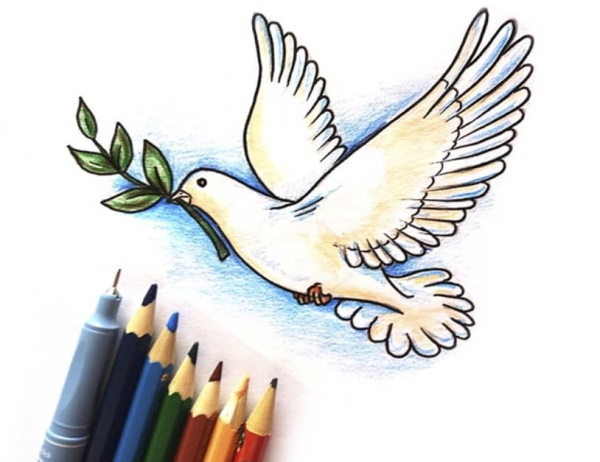
What shades are most often used to draw such birds:
- black;
- green;
- grey;
- brown;
- blue;
- violet;
- blue;
- orange.
It is worth paying attention to the hardness of the pencils. The number after the letter designation indicates that the lead of this pencil is softer or harder than the same one, but without a number. The higher the number after the letter "M", the easier the graphite is ground on paper. The numbers after the letter "T", on the contrary, indicate increased hardness.
Step by step pencil drawing tutorial
The dove (a drawing for older children should contain a lot of details) turns out realistic when drawn according to these instructions. You can use a simple pencil to draw the feathers, depict the rough surface of the paws and the shine of the beak.
Contours
The sketch is drawn with a hard pencil.

Procedure:
- Using a compass, draw a small circle in the center of the sheet.
- Draw a large oval under the circle. It will serve as the basis for the bird's body. This figure should be placed below the previously drawn circle. The contours of the figures should not intersect.
- The dove in the drawing will be turned sideways, so you need to draw 1 wing and 1 eye.
- Draw the dove's neck by connecting a circle and an oval with two smooth lines.
- Slightly going beyond the outline of the base, draw the shape of the wing. Doves have large wings, so you need to bring the line to the point where the tail will be drawn.
- Birds of this species have a protruding, rounded chest. It should be drawn beyond the contours of the oval.
- Draw a beak and a small round eye on the head.
- Finish drawing the tail. Doves have a short but lush tail. You can immediately outline individual feathers.
- Draw the shape of the feathers on the wing.
- Draw the legs. They should be meek and thick.
- On each foot, depict short toes with hooked claws.
Erase all unnecessary lines and strokes with an eraser.
Detailing
Details are drawn with a hard-soft pencil.
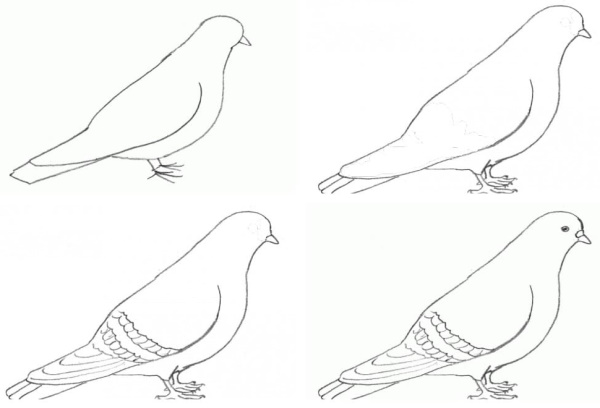
Procedure:
- Divide the large wing feathers into groups. Draw some small feathers.
- Draw wrinkles on the paws in the form of horizontal stripes.
- Outline the bird's cone with a zigzag line, imitating protruding fluff.
- Draw many small feathers on the chest.
- Under the paws, depict a branch on which a dove sits.
- Draw the bark on the tree, buds and small leaves with veins.
- Draw a nostril on the beak.
Erase any extra strokes with an eraser.
Shadows and highlights
- Shadows are indicated with strokes using a soft pencil.
- Shade the head with short vertical strokes.
- Paint the feathers on the wing. On large feathers, draw a line down the center and apply the strokes at an angle. On one side, they should be directed to the left, and on the other half, to the right.
- Shade the tail feathers in the same way.
- Without pressing on the pencil, you should color the lower part of the branch on which the dove sits, and also shade its beak.
- Show shadow on leaves.
- Shade the legs, as well as the bottom of the abdomen and chest.
- Use your finger to blend the strokes on the tree and belly.
- Use an eraser to erase a thin layer of graphite from the top of the beak. This will imitate a glare.
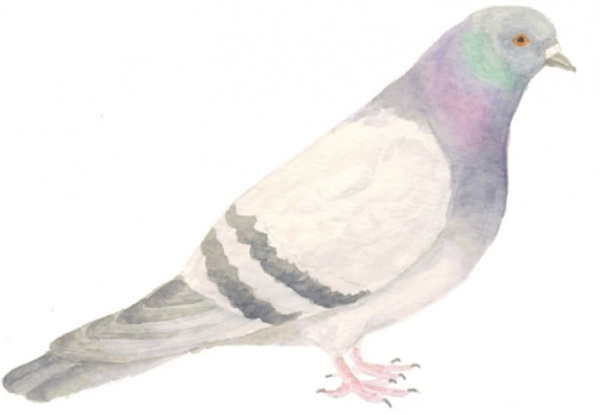
Use a soft pencil to outline the picture.
Pattern variations
A dove can be drawn using different techniques. It is important to choose a drawing style that suits the child's age. For small children, from 2 to 5 years old, large pictures without a lot of details are suitable.
Realistic drawing of all elements of the picture takes a lot of time, so the kids will quickly lose interest. They need simple kennels with wide areas for coloring in 1 tone, without color transitions and shadows.
Such difficulties can be overcome by primary school students. They need to train their hand to write beautifully, and children over 7 years old need to learn how to mix paint colors correctly and make shade transitions using other materials. Further in the article, you can consider a step-by-step description of drawing a dove in different techniques.
Finger painting
Children from 2 to 5 years old can be offered to draw a dove with their hands, without using brushes. For such an activity, you will need special paints that are easy to wash off your hands and do not cause allergic reactions on the skin.
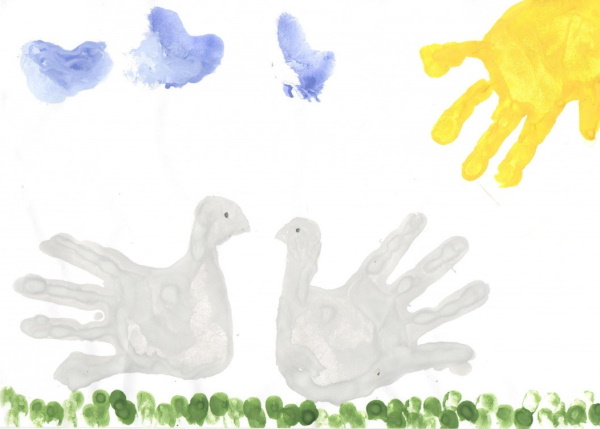
How to draw:
- Apply grey paint to the child's palm and ask him to draw a large circle. This will be the bird's body.
- Use grey paint to paint the neck and head of the dove.
- Take some purple paint, dip your fingers in it and stamp them on the bird's back. These will be the wings.
- Draw the tail in a similar manner.
- Dip 1 finger in blue paint and paint the top of the chest and neck using zig-zag motions.
- Apply orange color to the tip of the little finger and imprint it in place of the beak.
- Also, use your little finger to draw a white dot in the eye area.
- Draw the pupil with black paint.
After the paint has dried, you need to draw the dove's legs using a brown marker.
How to Draw a Dove with Colored Pencils
The dove (a drawing for children can be done with colored pencils) will turn out bright and "live" if you use colored materials. All strokes should be applied in the direction of the bird's feather growth.
This drawing technique is suitable for children from 8 to 14 years old.
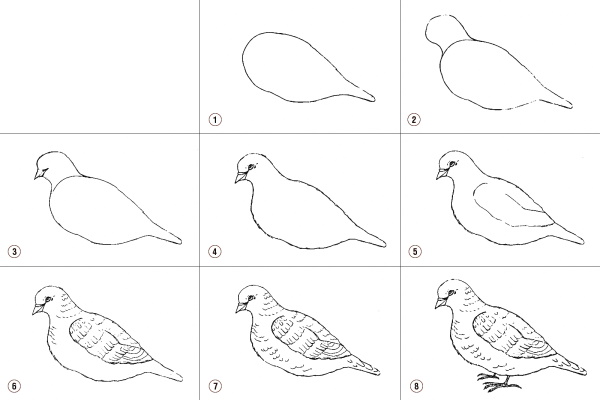
How to draw:
- Using a hard pencil, draw a small circle and a large oval underneath it.
- Connect the figures with smooth lines, drawing the shape of the neck.
- Draw a wing.
- Select the large, protruding breast.
- Draw a sharp beak.
- Draw a fluffy tail and outline large groups of feathers.
- Draw a small eye and color it.
- Draw the shape of the feathers on the wing.
- Add thick legs with hooked toes.
- Outline the contours of the body with short, broken lines.
- Use an eraser to remove excess lines.

- On the large feathers, draw the cores, using strokes to show the direction of their growth.
- Draw wrinkles and claws on the paws.
- Draw many small feathers on the chest.
- Finish drawing the branch on which the dove will sit.
- Draw a nostril on the beak.
- Use a grey pencil to shade the bird's abdomen, wing and head.
- Paint the back green.
- You need to paint the legs with brown, shade the branch and paint the chest.
- Paint the head and wings black.
- Use a blue pencil to color the tail feathers and add a few purple strokes to the wing feathers.
- Paint the bird's legs and beak orange.
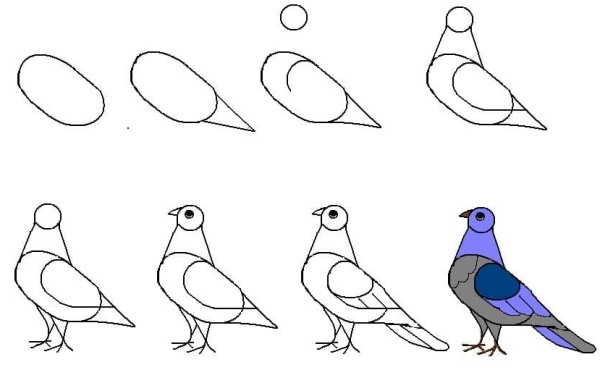
Trace the outline of the drawing with a black marker or gel pen.
Master class on drawing a dove with artistic pastels
A dove (a drawing for children can be done without using a simple pencil) can be schematically depicted on paper with a light crayon. This drawing technique is suitable for preschool children.
How to draw:
- Apply a few strokes of brown pastel to the abdomen, chest and upper part of the wing. Blend the pigment by rubbing it with your fingers.
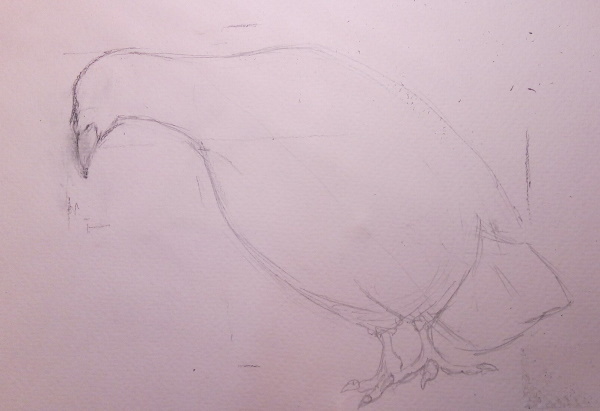
- Use grey and orange chalk to paint the feathers on the wings and tail. Rub the strokes to blend the colours.
- Paint the lower part of the wing with dark grey and blend.
- Spray the design with hairspray.
- Without waiting for it to dry, use purple chalk to outline the feathers on the tail and wing.
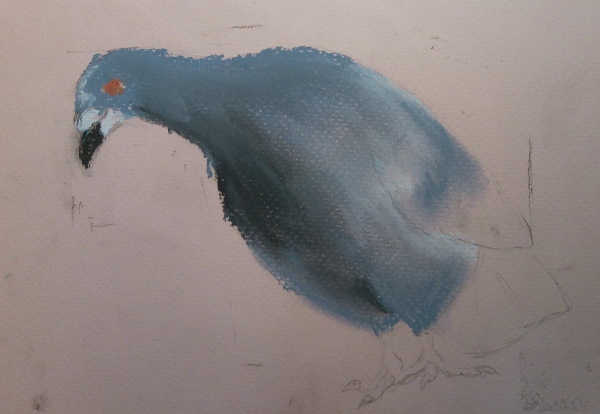
- Use dark brown to highlight the groups of small feathers on the chest.
- Paint the paws and beak orange.
- Use the edge of the chalk to draw 1 eye and color the beak.

- Cover the drawing with varnish again.
- Use white chalk to draw the core on the tail and wing feathers.

- Add a highlight inside the eye and on the top of the beak.
- Use brown chalk to draw a branch under the bird.
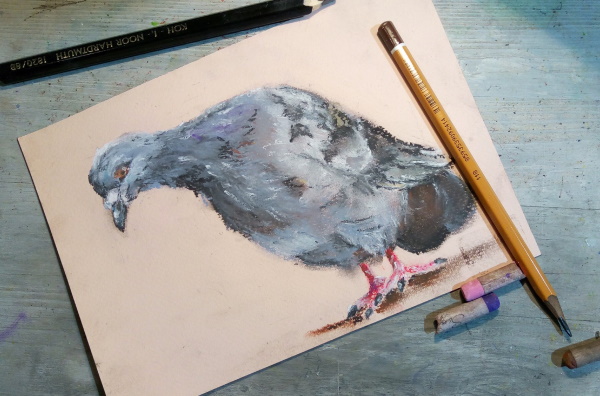
Finally, you need to cover the work with varnish again and leave it to dry.
How to draw a dove with markers
You can draw with felt-tip pens on any thick paper. To prevent the paint from soaking through the sheet and staining other pages of the album, you need to put cardboard under the page. The technique of drawing with felt-tip pens is suitable for children from 6 years old.
How to draw:
- Using a hard pencil, draw the outline of the pigeon's body and head.
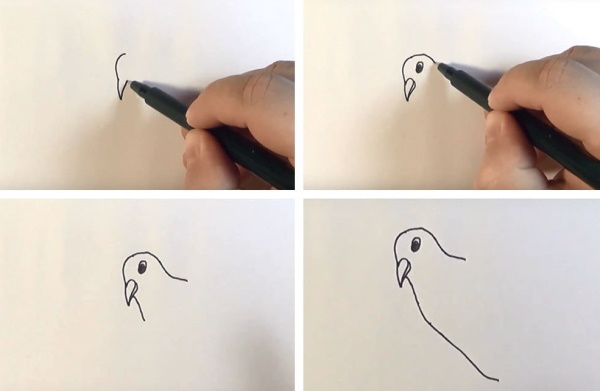
- Draw a wing, a triangular beak and an eye.
- Depict a lush tail with large feathers.
- Draw the feathers on the wing.
- Finish drawing thick legs and hooked toes.

- Use an eraser to remove excess lines.
- Draw wrinkles on the paws.
- Draw a nostril on the beak.
- Use a grey marker to shade the bird's belly, head and upper part of the wing.
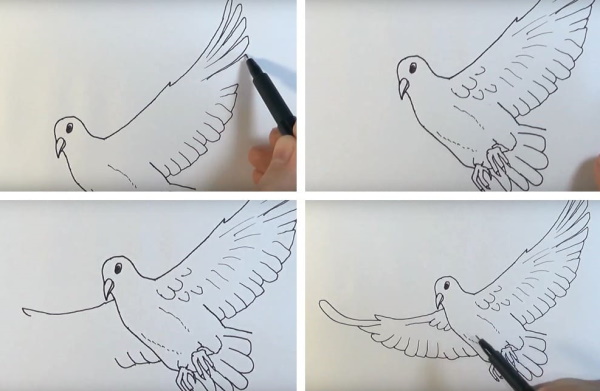
- Paint the bottom of the wing, as well as the neck and a few feathers on the tail, with brown.
- Use an orange marker to color the legs and beak.
- Paint the remaining feathers on the tail and wings with blue.
- Shade the neck and lower chest with dark blue.
- Outline all the feathers on the tail and wings around the kennel.
- Use a black marker to outline the drawing and color the eye.
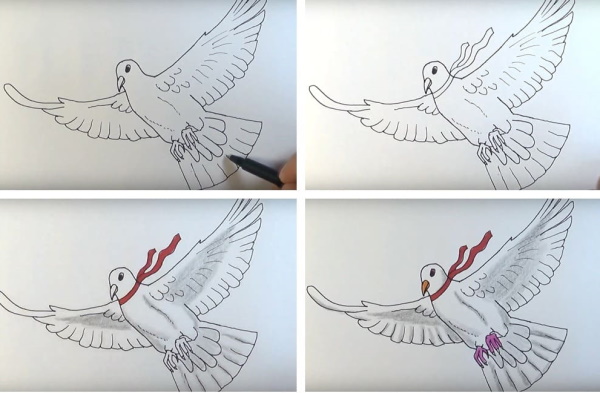
You need to draw carefully with felt-tip pens. You can't apply the pigment in several layers or make sharp movements. The wet tip of the felt-tip pen easily rubs the paper until it makes holes.
All strokes should be applied in 1 direction.
Step by step instructions on how to paint a dove
The dove (a drawing for children can be done with different paints) can be painted with watercolors, gouache or acrylic.
This master class describes the process of painting a dove with watercolors:
- Using a hard pencil, make a schematic sketch.
- Using a compass, draw a circle in the center of the sheet.

- Step down a little and draw an oval. The figure should be placed at an angle. Its top is the upper part of the pigeon's chest, and the bottom part will be the tail.
- Connect the circle and the top of the oval with smooth lines, depicting the bird's neck.
- Outline the shape of the tail and wings.
- Draw large groups of feathers.
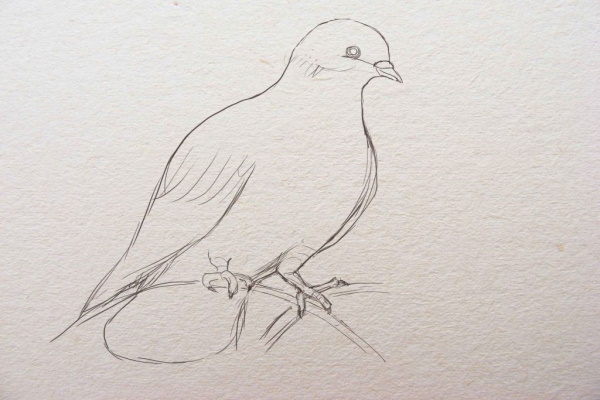
- Draw thick legs and hooked toes with claws.
- Add a small eye, draw a triangular beak.
- Draw a tree branch under the paws.
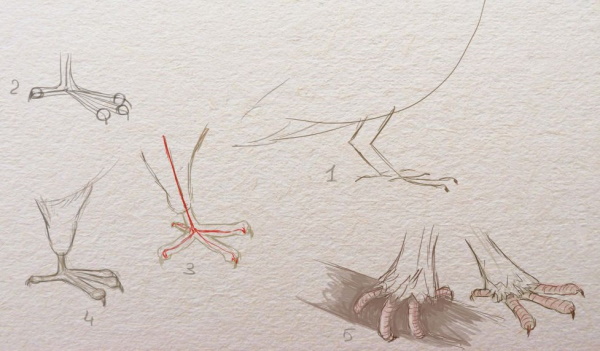
- Draw small branches, buds and leaves on it.
- Erase extra lines.
- Before coloring, the paper should be moistened. Wet a wide brush with soft bristles in water and squeeze it on the edge of the jar. Go over the sheet with it. Do not press hard, so as not to smear the pencil sketch. Do not wet the paper too much, otherwise it will deform.
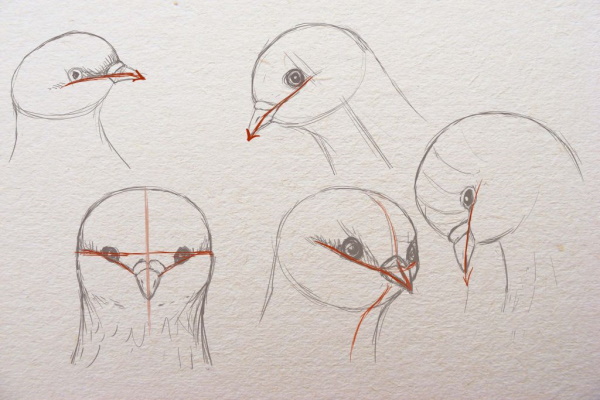
- Using a small brush, pick up some brown paint and paint the bird's belly, as well as the upper part of the wings and the top of the chest.
- Dilute black watercolor with water in a 1:1 ratio. Paint the bird's body with this liquid. Sketch the wing, neck, and lower part of the chest.
- The paint will spread, and streaks along the outline of the drawing will imitate protruding fluff and small feathers.
- Add some blue to the wings. You need to paint over the gray color before it dries completely. The colors should not mix completely, but the transitions from one color to another should be smooth.
- Wait until all paints are completely dry.
- Change the brush to a thinner one.
- Dip the brush in dark brown paint and paint the feathers on the chest.
- Outline the large feathers on the tail and wings in blue.
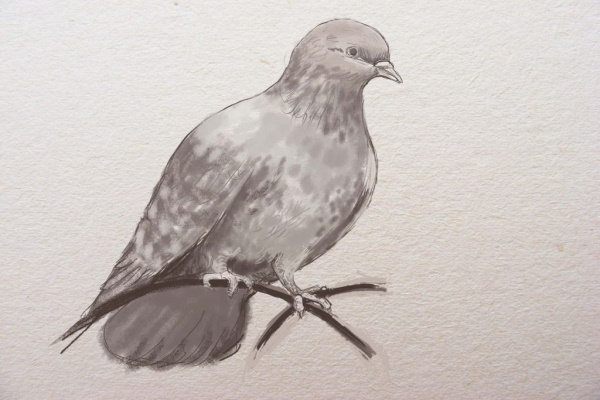
- Paint the top of the head.
- Paint the legs and beak with orange paint.
- Dry the drawing. Apply a few strokes of white paint to the feathers on the wings and tail.
- Paint the branch under the bird brown.
- Draw the veins on the leaves with dark green paint, then let them dry. Then, using a clean, wet brush, lightly shade the lines inside each leaf.
Dry the drawing and, if desired, outline it with a black gel pen.
Examples of images for copying, tips for beginners
There are some guidelines that beginner artists should follow:
- To create a realistic drawing, you should have a sample with a real image of a dove in front of your eyes. You can print a photo of the bird and attach it to the corner of the canvas or put it on the table.
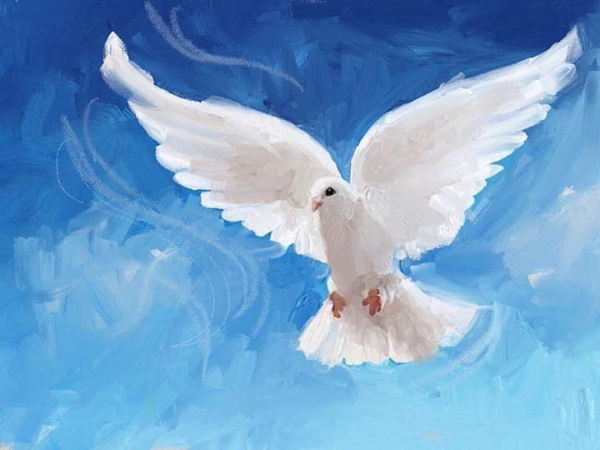
- When painting a picture with gouache or acrylic paints, there is no need to wet the paper first.
- Finger paint can be washed off your hands with wet wipes. You don't have to wash your hands under the tap every time you want to change colors.
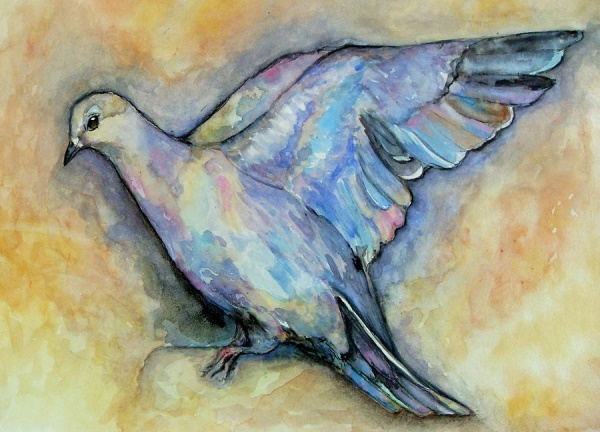
- To achieve a smooth transition of shades when coloring a drawing with felt-tip pens, you need to alternate strokes of different colors.
- When fixing a pastel drawing with varnish, the spray can should be held at a distance of about 20-25 cm from the paper. If you hold it closer, the sheet may deform from moisture, and dry particles will mix and begin to spread.
- To blend pastel or pencil within a small part of the drawing, you can use a cotton swab dipped in water.

- White paint can be replaced with corrector.
- It is not advisable to outline watercolor drawings. They lose their lightness and become rough and sharp.
- To make the paint dry faster, you can use a hair dryer.
- Warped paper can be smoothed out by placing it under a press for 24 hours after drying.
- Pencil and pastel strokes should be shaded lengthwise, not across.

- When drawing a gray dove, you need to use different shades of this color. Some areas should be painted dark, and others light. Shadows can be indicated with black. The paints should be diluted with water, and several small strokes should be applied with pencils and rubbed.
- Dark colored birds will have brown legs and beak. White pigeons will have gray legs and beak. Orange can be used to paint these body parts of birds with tricolor plumage.
- Doves have small eyes, so it is quite difficult to draw a highlight inside them. You can put a white dot with a corrector.
Drawing pigeons will help a child learn to distinguish these birds from other species. Parents should draw together with their children, explaining to them during the lesson who pigeons are, what benefits they brought to people before, what they eat and what sounds they make.
This information is needed to maintain the child's interest in drawing, and it will also be useful for general development. The picture for copying can be selected from the options presented in the article.
Video about drawing a dove
How to draw a dove with pencils:
